Ganymede (mythology)
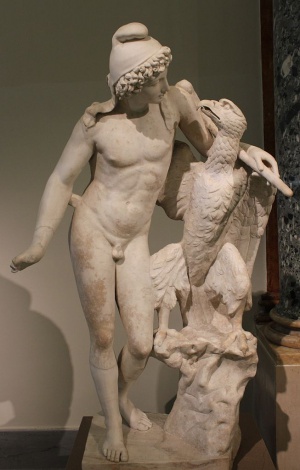
Ganymede, a beautiful youth that became one of Zeus' lovers, is the iconic example of the beloved boy in Greek mythology, and references to him in art and literature are often allusions to pederasty.
He was a prince of Troy, son of the eponymous Tros of Dardania and of the nymph Callirrhoe, and brother of Ilus and Assaracus.[1] One source of the myth says that Zeus fell in love with Ganymede when he spotted him herding his flock on Mount Ida near Troy in Phrygia. Zeus then sent his eagle or came down in the form of one to carry Ganymede to Mount Olympus.[2] Ganymede had been tending sheep, a rustic or humble pursuit characteristic of a hero's boyhood before his privileged status is revealed.
In the Iliad, Zeus is said to have compensated Ganymede's father Tros by the gift of fine horses, "the same that carry the immortals",[3] delivered by the messenger god Hermes. Tros was consoled that his son was now immortal and would be the cupbearer for the gods, a position of much distinction.
In Olympus, Zeus granted him eternal youth and immortality and the office of cupbearer to the gods, supplanting Hebe. All the gods were filled with joy to see the youth, except for Hera, Zeus's consort, who regarded Ganymede as a rival for her husband's affection. Zeus later put Ganymede in the sky as the constellation Aquarius, which is associated with that of the Eagle (Aquila).
A moon of Jupiter, the planet named for Zeus's Roman counterpart, was named Ganymede by astronomer Simon Marius.[4]
Ancient art
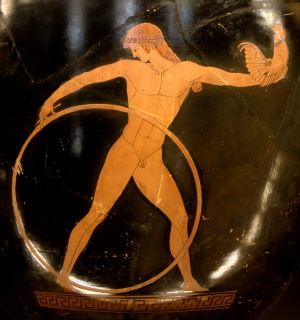
One of the earliest depictions of Ganymede is a red-figure krater by the Berlin Painter in the Musée du Louvre.[5] Zeus pursues Ganymede on one side (see Zeus), while on the other side the youth runs away, rolling along a hoop while holding aloft a crowing cock. In fifth-century Athens, vase-painters often depicted the mythological story, which was so suited to the all-male symposium.[6] The two images taken together convey the pederastic or sexual nature of the relationship.
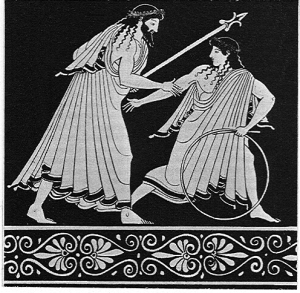
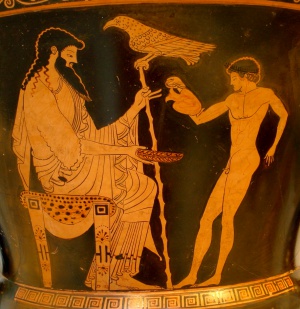
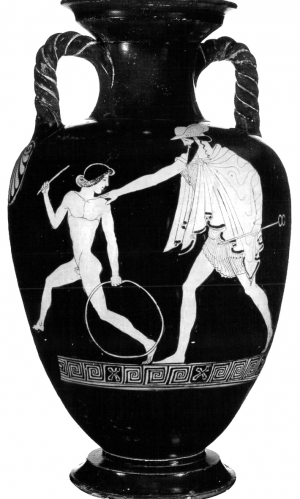
A scene on this amphora depicts the pursuit of Ganymede, who runs away with a hoop and a stick. The painter didn't show Zeus carrying out the abduction, however, which would follow the usual iconography, but Hermes, messenger of the gods.[7]
See also
- Zeus (mythology)
- Apollo (mythology)
- Hyacinth (mythology)
- The Church of Zeus and Ganymede
- The Exquisite Corpse of Ganymede by Andrew Calimach
References
- ↑ http://www.thefullwiki.org/Ganymede_%28mythology%29
- ↑ https://pantheon.org/articles/g/ganymede.html
- ↑ The Achaean Diomedes is keen to capture the horses of Aeneas because "they are of the stock that great Zeus gave to Tros in payment for his son Ganymede, and are the finest that live and move under the sun": Iliad 5.265ff.
- ↑ Marius/Schlör, Mundus Iovialis, p. 78 f. (with misprint In for Io)
- ↑ http://www.louvre.fr/en/oeuvre-notices/attic-red-figure-bell-krater
- ↑ http://en.wikipedia.org/wiki/Ganymede_%28mythology%29
- ↑ https://www.hermitagemuseum.org/wps/portal/hermitage/digital-collection/25.+Archaeological+Artifacts/411266